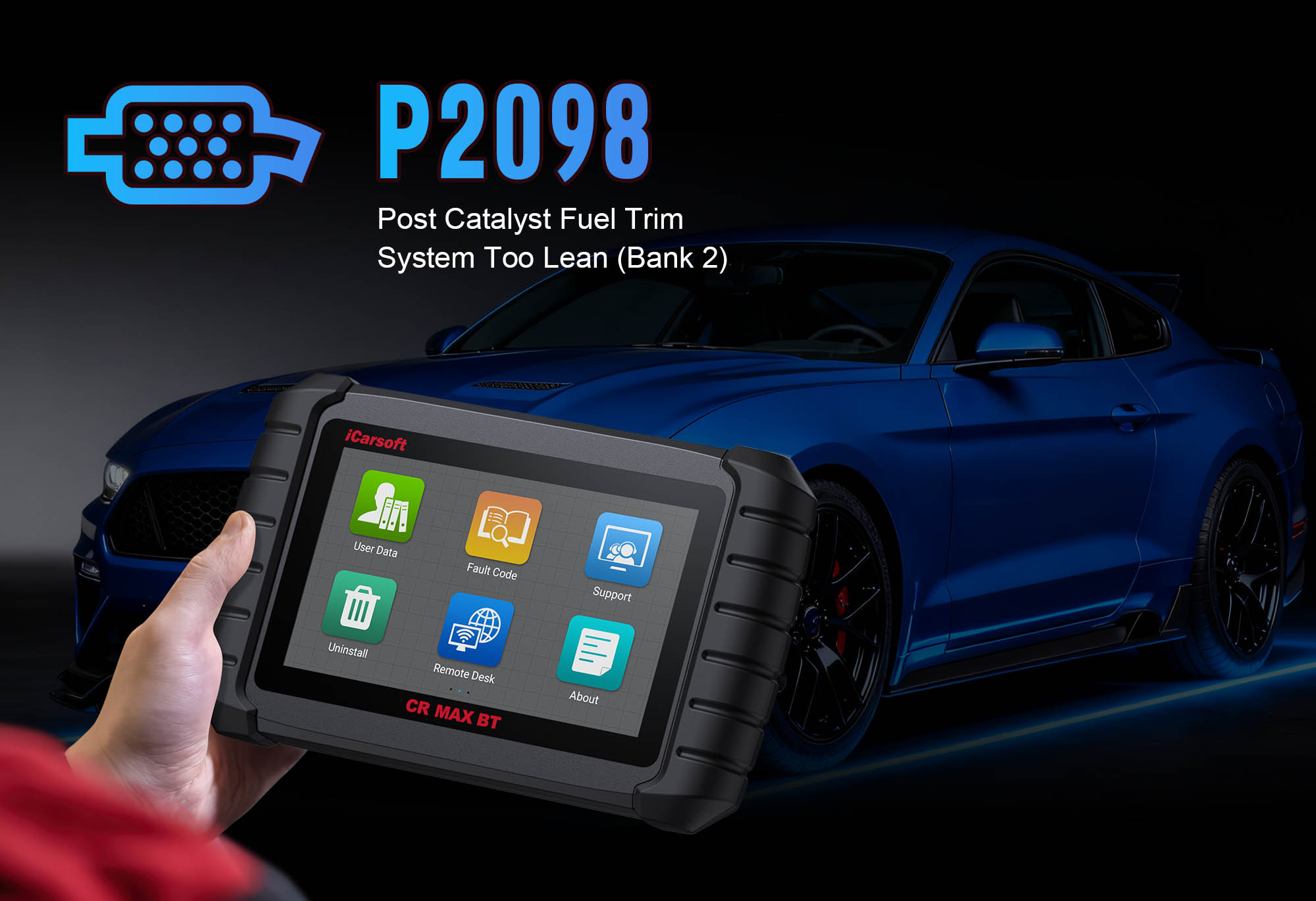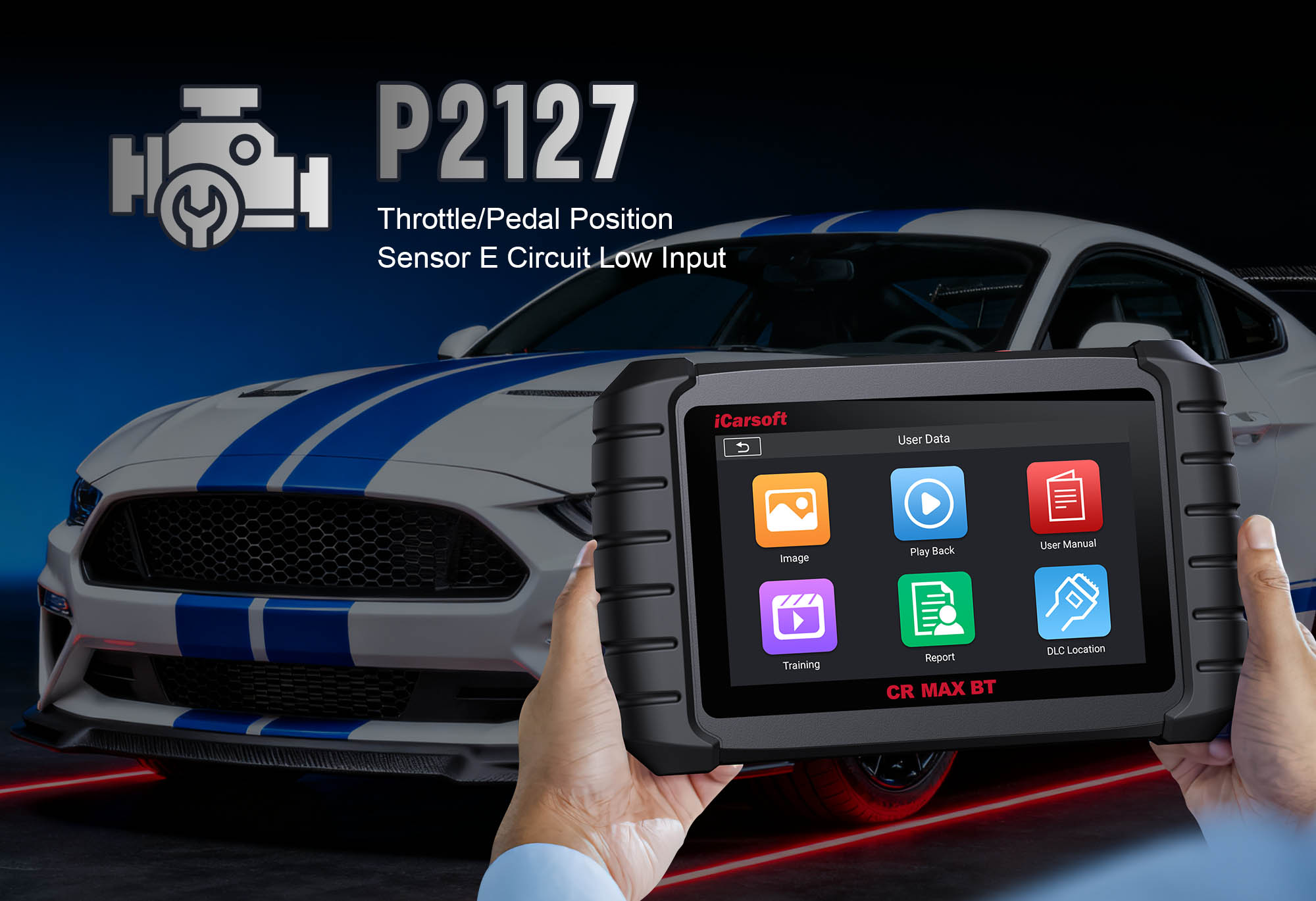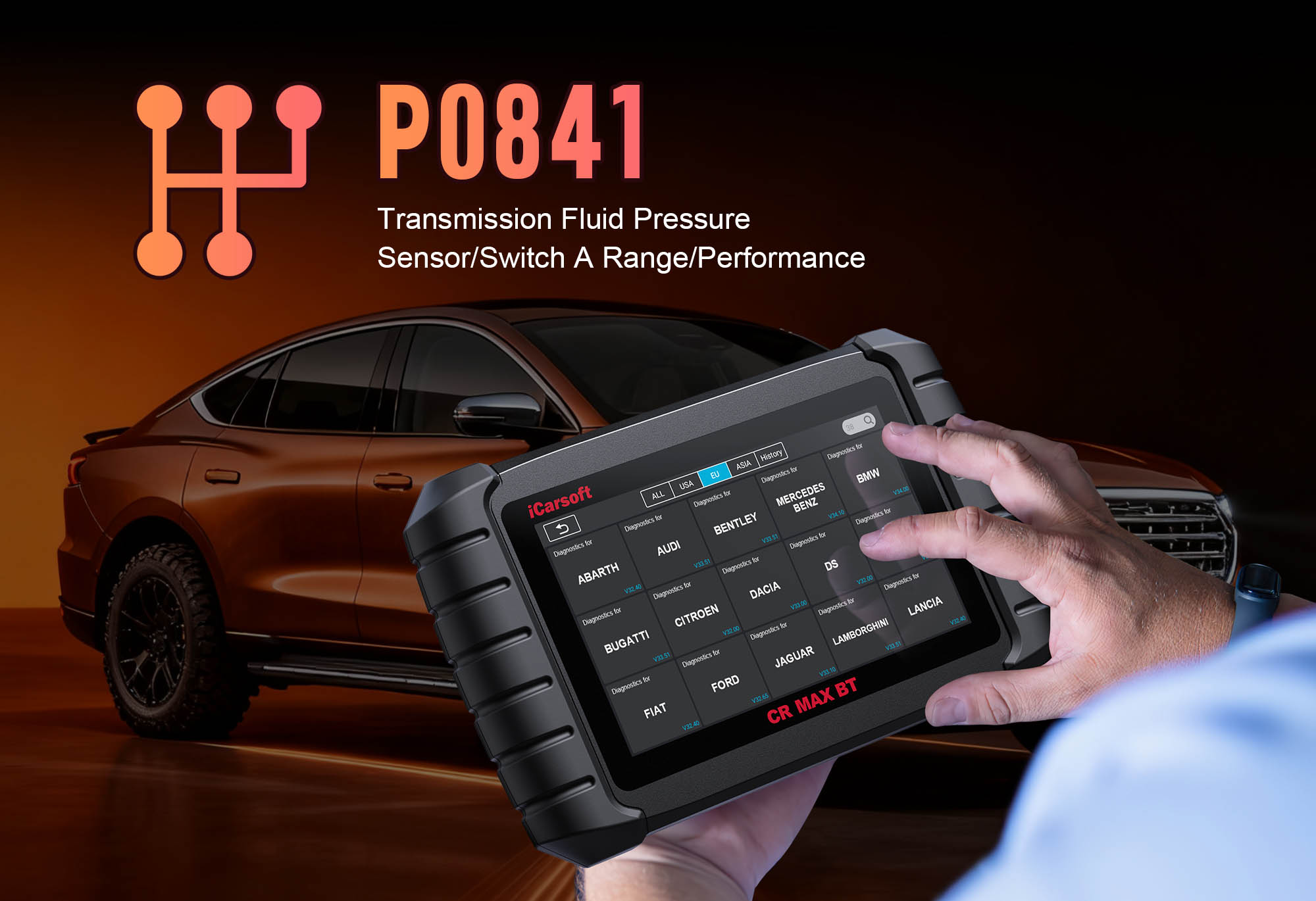Diagnose & Clear P2098 with iCarsoft CR MAX BT: Fix Post-Catalyst Fuel Trim System Too Rich - Bank 2
Diagnose & Clear P2098 with iCarsoft CR MAX BT
If your vehicle’s Check Engine Light illuminates, you notice reduced fuel efficiency, or it emits a strong gasoline odor from the exhaust, a diagnostic scan will likely return P2098. This OBD-II code stands for "Post-Catalyst Fuel Trim System Too Rich - Bank 2"—a fault indicating the air-fuel mixture in Bank 2 (cylinder bank with the second cylinder in firing order) remains excessively rich after passing through the catalytic converter.
The Engine Control Module (ECM) relies on oxygen (O2) sensors before and after the catalyst to adjust fuel delivery. When the post-catalyst O2 sensor detects unburned fuel (rich mixture), it triggers P2098—alerting to potential catalyst damage, increased emissions, and wasted fuel. Basic scanners only flag a "rich mixture," but the iCarsoft CR MAX BT with specialized fuel system diagnostics solves this. Let’s break down how to resolve P2098 step by step.
Understanding P2098: Causes & Key Symptoms
Fuel trim refers to the ECM’s adjustments to maintain a 14.7:1 air-fuel ratio (ideal for gasoline engines). "Too rich" means excess fuel relative to air, leading to unburned hydrocarbons in exhaust. Bank 2’s post-catalyst O2 sensor detects this imbalance, while the pre-catalyst sensor monitors the mixture before the catalyst. P2098 triggers when the post-catalyst sensor reports a rich mixture consistently—even after the ECM tries to lean out fuel trim.
Key Symptoms of P2098
-
Check Engine Light (CEL): A steady CEL illuminates, often paired with a "Fuel System Rich - Bank 2" dashboard message.
-
Reduced Fuel Efficiency: Excess fuel use drops mileage by 10–20% (e.g., from 30 mpg to 24 mpg).
-
Exhaust Odors: Strong unburned gasoline smell from the tailpipe, especially under acceleration.
-
Catalytic Converter Damage: Unburned fuel ignites in the catalyst, causing overheating and internal melting (costly to replace).
-
Poor Performance: Hesitation during acceleration or rough idle, as the rich mixture disrupts combustion.
Common Causes of P2098
|
Cause
|
Description
|
|
Faulty Post-Catalyst O2 Sensor (Bank 2)
|
Worn or contaminated sensor (from oil/fuel additives) sends incorrect rich-mixture signals to the ECM, even with a balanced mixture.
|
|
Clogged Fuel Injectors (Bank 2)
|
Partially clogged injectors leak or dribble fuel, flooding cylinders and creating a rich mixture.
|
|
Exhaust Leaks (Bank 2)
|
Leaks before the post-catalyst O2 sensor draw in extra oxygen, tricking the sensor into reading a "rich" condition.
|
|
Malfunctioning MAF Sensor
|
Dirty or faulty Mass Airflow (MAF) sensor underreports airflow, causing the ECM to add excess fuel.
|
|
Fuel Pressure Issues
|
Stuck-open fuel pressure regulator or failing fuel pump increases pressure, forcing more fuel into Bank 2 cylinders.
|
|
PCV System Leaks
|
Cracked PCV valve or hose allows oil vapor into the intake, enriching the mixture in Bank 2.
|
Why iCarsoft CR MAX BT Excels at Diagnosing P2098
The CR MAX BT outperforms basic tools with features tailored to fuel trim and O2 sensor diagnostics—critical for resolving P2098 accurately:
Wireless Bluetooth Connectivity
Test Bank 2 sensors and fuel components (injectors, MAF) from 30 feet away—no cords hinder engine bay/undercarriage access.
Live Fuel Trim & O2 Data
Monitors real-time Bank 2 STFT/LTFT and pre/post-catalyst O2 voltage, instantly flagging rich conditions (LTFT > +10%, O2 > 0.8V).
Bank-Specific Diagnostics
Isolates Bank 2 issues with clear data labeling, avoiding misdiagnosis of cross-bank faults (e.g., confusing Bank 1 vs. Bank 2).
AutoVIN Identify
Automatically detects engine type, Bank 2 location, and sensor specs in seconds—eliminates manual engine diagram lookup.
Bi-Directional Sensor Tests
Sends commands to activate O2 sensors/injectors, verifying responsiveness and ruling out stuck components.
Step-by-Step: Diagnose P2098 with iCarsoft CR MAX BT
-
Safety First & Initial Visual Inspection
1. Disconnect battery: Turn off ignition, remove negative terminal (wrench) to avoid sparking near fuel components.
2. Locate Bank 2 components: Use Component Location > Engine > Fuel System > Bank 2 to find post-catalyst O2 sensor, injectors, and exhaust parts.
3. Inspect for issues:
- O2 sensor wires: Check for frayed/melted wires (from exhaust heat).
- Fuel injectors: Look for leaks around O-rings.
- PCV system: Inspect hoses for cracks; shake PCV valve (rattle = good, no rattle = stuck).
- Exhaust: Check for rust holes, loose flanges, or damaged gaskets near Bank 2.
-
Connect Tool & Confirm P2098
Reconnect battery, plug CR MAX BT into OBD-II port, select AutoVIN Identify to retrieve engine specs. Navigate to Engine > Fault Codes > Read Codes to confirm P2098. Tap Code Details for vehicle-specific insights (e.g., "Chevrolet: Post-Catalyst LTFT +15%, Post-O2 0.85V"). Check related codes (P0172, P2096) and resolve P2098 first.
-
Monitor Live Fuel Trim & O2 Data
1. Start engine, warm to operating temperature (10–15 minutes).
2. Navigate to Engine > Live Data > Fuel Trim & O2 Sensors; monitor Bank 2 metrics:
- LTFT: Normal = -10% to +10%; P2098 shows LTFT > +10% (ECM adding excess fuel).
- Post-Catalyst O2 Voltage: Normal = slow 0.1V–0.9V fluctuations; steady >0.8V = rich.
- Pre-Catalyst O2 Voltage: Normal = rapid fluctuations; steady high = rich mixture starts in engine.
3. Load test: Accelerate gently—LTFT spikes = fuel pressure/injector issues.
-
Test O2 Sensors & Fuel Components
1. O2 sensor response test: Navigate to Special Functions > Engine > O2 Sensor Test; select "Bank 2, Post-Catalyst." Slow/unchanging voltage = faulty sensor.
2. Injector balance test: Use Bi-Directional Tests > Fuel Injectors > Bank 2; deactivate each injector—no RPM drop = clogged injector.
3. Fuel pressure check: Monitor Engine > Live Data > Fuel Pressure (or use manual gauge); high pressure = regulator/pump fault.
4. MAF test: Watch Live Data > MAF Airflow—erratic/low readings = dirty/faulty MAF (clean with MAF cleaner).
-
Repair Exhaust Leaks & PCV Issues
1. Exhaust leak detection: Spray soapy water on Bank 2 exhaust connections—bubbles = leaks; tighten bolts or replace gaskets. Small holes = exhaust tape; large holes = pipe replacement.
2. PCV repair: Replace stuck PCV valve (use Part Lookup) and cracked hoses. Test by pinching PCV hose—idle drop = good function.
-
Repair & Clear P2098
- Faulty O2 sensor: Replace Bank 2 post-catalyst sensor (use anti-seize, torque 30–35 ft-lbs); run O2 Sensor Relearn.
- Clogged injectors: Clean with ultrasonic cleaner or replace; use Injector Calibration to sync with ECM.
- Fuel pressure issues: Replace regulator/pump; recheck pressure post-repair.
- MAF issues: Clean or replace; verify airflow readings.
Clear code: Engine > Fault Codes > Clear Codes—confirm P2098 is deleted.
-
Validate the Repair
1. Post-repair check: Warm engine, confirm Bank 2 LTFT (-10% to +10%) and post-catalyst O2 voltage (normal fluctuations).
2. Test drive (30–40 minutes): Check for smooth acceleration, no exhaust odors, and stable fuel trim.
3. Emissions test: Use I/M Readiness Test to confirm catalyst monitor is "Ready" (critical for state inspections).
4. Save report: Document fault/repairs via History & Report.
Preventing P2098 Recurrence
-
Regular O2 Sensor Checks: Use Service Reminder to test post-catalyst sensors every 60,000 miles; replace every 100,000 miles.
-
Fuel System Maintenance: Clean injectors and replace fuel filters every 30,000 miles (follow Maintenance Schedule).
-
MAF/PCV Care: Clean MAF every 15,000 miles; inspect PCV components every 20,000 miles (use System Checks).
-
Lifetime Updates: Use One-Key Upgrade to add new fuel trim diagnostic features (e.g., catalyst health monitoring).
Conclusion
P2098’s post-catalyst rich mixture isn’t just a fuel efficiency issue—it risks destroying your catalytic converter (a $1,000+ repair) and increasing emissions. The iCarsoft CR MAX BT simplifies diagnosis with wireless convenience, live fuel trim tracking, and sensor tests—ensuring you fix the root cause (faulty O2 sensor, injector, or leak) instead of guessing.
With global vehicle coverage, 40+ service functions, and lifetime updates, the CR MAX BT is a long-term investment in fuel system balance and emissions compliance. Restore mileage, protect your catalyst, and drive with confidence—all with one professional-grade tool.




